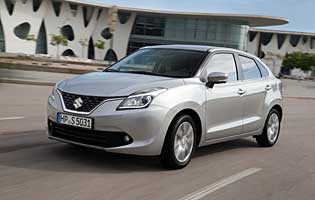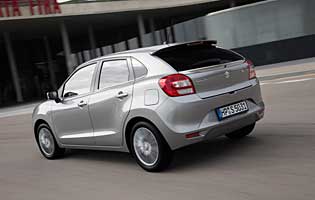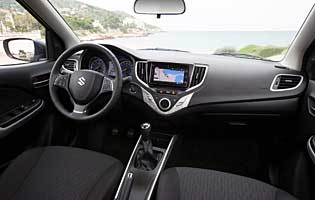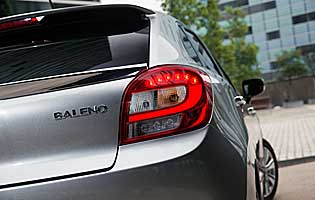



Overall rating
![]()
The conventional little Baleno is unlikely to age well




![]()
Suzuki is best known for producing small, practical and reliable cars. Models such as the Swift and the Vitara have a cult-like following, with loyal owners returning for more every few years. Now, Suzuki has introduced a slightly larger small car so that families can grow with the brand.
The Suzuki Baleno is a new entrant to the hatchback fray. Suzuki excels at making this sort of car, so it should come as no surprise to anyone (fans of the brand or otherwise) that the Baleno continues the tradition of being a cheap-and-cheerful runaround that won't let you down.
Suzuki has squeezed 110bhp out of the clever Boosterjet engine. Even more impressively, the little engine delivers 90 per cent of its torque at just 1,500rpm. This low-rev oomph combined with a modest kerb weight gives the understated little Baleno a lively personality.
There's also a 1.2-litre engine with a basic mild hybrid system. It's substantially less fun to drive and doesn't reduce fuel consumption significantly enough to be recommended - Suzuki estimates that this engine will account for around one in ten UK sales.
Customers loyal to Suzuki's reliability, practicality, quirkiness and no-nonsense lack of pretence will be delighted with this spacious B-segment hatchback. By building a car larger than the Swift, Suzuki has enabled its dedicated followers - and newcomers - to grow with the brand, rather than defecting to VW, Ford or Hyundai.
The Suzuki Baleno is a cheap family runabout that excels where it matters. It's very easy to drive, the boot is the largest in its category and the interior will stand all the tests of family life. What it lacks in badge appeal, styling and luxury it makes up for in reliability, practicality and rarity - an excellent family choice.
Prices haven't been revealed yet but a base model should cost around GBP12,000 and the top-of-the-range version around GBP14,000. Insurance will be cheap, as will fuel and tax. Only the weak hybrid qualifies for free tax at the moment, but the petrol will be in the lowest band.
335 litres of boot space give the Baleno more luggage capacity than its competitors. Clever arrangement of the rear suspension enabled Suzuki to build a much squarer cargo space than other B-segment hatchbacks. Oddment boxes and door bins appear throughout, and are generously proportioned and well placed.
The interior is pleasing to look at and intuitive to use. All of the interior plastics - all - feel quite cheap, in a utilitarian rather than fragile way. The seven-inch monitor looks almost like a retrofitted Halfords addition but is clear to read. The instrument binnacle is among the best in the category for ease of use.
The seats in the front and rear of the Baleno are spacious and supportive. The front seats are easy to adjust, even for tall drivers, and the back seats are already in a good position for passengers of all sizes. An extra 7cm over the Swift should please tall rear passengers - people over 6' will have no problems in the back of the Baleno.
The Baleno isn't a very attractive object to thieves, and Suzuki hasn't released the full security offering yet. An alarm and central locking should be standard across the range.
The Suzuki Baleno has yet to be tested by Euro NCAP, but Suzuki has attained good results with its other modern vehicles. Radar brake support enables the car to take action when it detects a potential imminent collision - it can alert the driver, then increase braking force, then even automatically brake. The Baleno has six airbags.
We drove a pre-production model, which we're told will continue to be worked on until it goes on sale in 2016. In its current form, the Baleno is a lively and entertaining little hatchback that outperforms most of its contemporaries in terms of 'fun' but falls behind stars like the Fiesta for all-round driving pleasure.
Designed for families, the Baleno is the first Suzuki that UK buyers can pick when they start to have children. The Swift isn't quite large enough for a growing family, and the Vitara is often too big. If you want a cheap-and-cheerful runabout for your growing tribe, and don't care about image or luxury, the Baleno is a sensible pick.
Easy to use, cheap to run and difficult to break, the Suzuki Baleno might be the ultimate first car. It won't be the coolest ride in the school car park, but it's guaranteed to start every morning and won't cost a fortune to insure. The Suzuki Baleno is an ideal second car for a family with a young driver.
The levels of quality and image are rather disconnected when it comes to Suzuki. The cars are known for their reliability rather than their sophistication - nobody in the UK will be buying a Baleno to keep up with the Joneses. This rugged, no-nonsense family car is the hatchback equivalent of the legendary off-roader, the Suzuki Jimny.
The doors open wide and the seats are easy to climb in and out of. Rear legroom is generous enough for exiting the back seats to be more dignified than in a Polo or Fiesta. The boot is the largest in the class but does have a lip, making it slightly difficult to lift heavy luggage into it.
The sound system in the Baleno is good at drowning out the road, wind and engine noise. Integrating a mobile phone with the infotainment system is straightforward, and call quality is high. A seven-inch touchscreen appears in all models and there's even a G-meter on the dashboard - more gadgets than most cheap hatchbacks.
The Baleno's selection of nine paint jobs includes ""Ray Blue Pearl Metallic"", which changes colour depending on ambient lighting. We'd recommend against ordering this or the boring greys and browns - leave those to the compact execs - and explore brighter options. The trim is old-fashioned throughout but inoffensive, with few distinguishing features.
The Baleno has good visibility and a small turning circle. It's easy to park, and the steering is pleasantly light. The front of the car is high enough to pass over kerbs rather than hit them. All of the doors open wide when they need to, but the aperture is large enough to enter and exit the car in cramped parking spaces.
Emergency tyre repair kit supplied as standard.
Diesel engine options - 2.1-litre (167bhp, 201bhp). Transmission options: nine-speed automatic gearbox only. Trim levels: SE, Sport, AMG Line.
Dacia Sandero Sacrifice safety but spend half as much as the Baleno costs
Dacia Duster For the same as the Baleno, the Duster has 4x4 functionality
Ford Fiesta This much smaller car is still one of the best to drive
Volkswagen Polo An upmarket supermini with a desirable badge